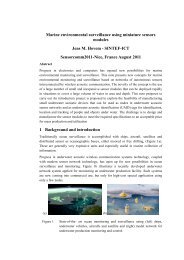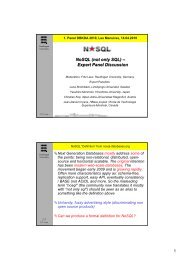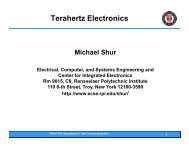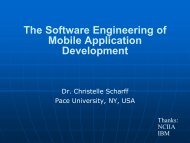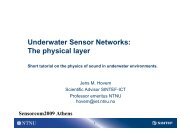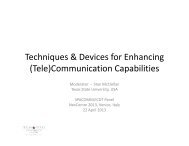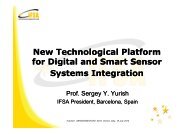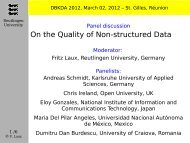PANEL BIO: Are the Current BIO-models Powerful Enough? - iaria
PANEL BIO: Are the Current BIO-models Powerful Enough? - iaria
PANEL BIO: Are the Current BIO-models Powerful Enough? - iaria
Create successful ePaper yourself
Turn your PDF publications into a flip-book with our unique Google optimized e-Paper software.
Bionature, Lisbon, Portugal<br />
27 March 2013<br />
<strong>PANEL</strong> <strong>BIO</strong>:<br />
<strong>Are</strong> <strong>the</strong> <strong>Current</strong> <strong>BIO</strong>-<strong>models</strong><br />
<strong>Powerful</strong> <strong>Enough</strong>?<br />
Moderator<br />
Son Nghiem, Jet Propulsion Laboratory, California Institute of Technology, USA<br />
Panelists<br />
• Hiroshi Toyoizumi, Waseda University, Japan: “Advantage of using applied<br />
probability <strong>the</strong>ory in bio-techonolgy”<br />
• Eduardo dos Santos, Universidade, Brazil: “<strong>Are</strong> <strong>the</strong> current <strong>models</strong><br />
sufficient to predict <strong>the</strong> druggable and <strong>the</strong>rapeutic targets that we need?”<br />
• Hesham Ali, University of Nebraska, Omaha, USA: ”Biological Network”<br />
• Son Nghiem, Jet Propulsion Laboratory, California Institute of Technology,<br />
USA: “Malaria Model”<br />
© 2013. All rights reserved.
Key Points from Panel<br />
• While bio-research can target specific areas or topics, it<br />
should be carried out as a part of a coordinated system<br />
ra<strong>the</strong>r than isolated stand-alone effort in order to<br />
optimize <strong>the</strong> value from <strong>the</strong> research.<br />
• Bio-modeling should break <strong>the</strong> traditionally boundary to<br />
become extensively interdisciplinary; e.g., to include<br />
applied probability <strong>the</strong>ory, computing and internet<br />
advances, or satellite observations.<br />
• A system for bio-information should be developed and<br />
sustained with contributions from researchers,<br />
institutions, and countries with specific protocols for<br />
data formats and policies to serve to common interests<br />
of academia, governments, and industries.<br />
• Diversified funding supports are important to sustain<br />
research system.
Bionature, Lisbon, Portugal<br />
27 March 2013<br />
<strong>PANEL</strong> <strong>BIO</strong>:<br />
<strong>Are</strong> <strong>the</strong> <strong>Current</strong> <strong>BIO</strong>-<strong>models</strong><br />
<strong>Powerful</strong> <strong>Enough</strong>?<br />
Moderator<br />
Son Nghiem, Jet Propulsion Laboratory, California Institute of Technology,<br />
USA<br />
Panelists<br />
• Hiroshi Toyoizumi, Waseda University, Japan: “Advantage of using applied<br />
probability <strong>the</strong>ory in bio-techonolgy”<br />
• Eduardo dos Santos, Universidade, Brazil: “<strong>Are</strong> <strong>the</strong> current <strong>models</strong><br />
sufficient to predict <strong>the</strong> druggable and <strong>the</strong>rapeutic targets that we need?”<br />
• Hesham Ali, University of Nebraska, Omaha, USA: ”Biological Network”<br />
• Son Nghiem, Jet Propulsion Laboratory, California Institute of Technology,<br />
USA: “Malaria Model”
Key Points from Panel<br />
• While bio-research can target specific areas or topics, it<br />
should be carried out as a part of a coordinated system<br />
ra<strong>the</strong>r than isolated stand-alone effort in order to<br />
optimize <strong>the</strong> value from <strong>the</strong> research.<br />
• Bio-modeling should break <strong>the</strong> traditionally boundary to<br />
become extensively interdisciplinary; e.g., to include<br />
applied probability <strong>the</strong>ory, computing and internet<br />
advances, or satellite observations.<br />
• A system for bio-information should be developed and<br />
sustained with contributions from researchers,<br />
institutions, and countries with specific protocols for<br />
data formats and policies to serve to common interests<br />
of academia, governments, and industries.<br />
• Diversified funding supports are important to sustain<br />
research system.
University of Nebraska at Omaha<br />
<strong>Are</strong> <strong>the</strong> <strong>Current</strong> Bio-<strong>models</strong> <strong>Powerful</strong> <strong>Enough</strong>?<br />
<strong>BIO</strong>TECHNO 2013<br />
Hesham H. Ali<br />
UNO Bioinformatics Core Facility<br />
College of Information Science and Technology
Biomedical Informatics – Where are we?<br />
• Availability of many large useful database systems;<br />
private and public<br />
• Advances in new technologies as high throughput next<br />
generation sequencing<br />
• Availability of numerous helpful software tools<br />
• Fragmented, in some case isolated, efforts by<br />
computational scientists and bioscientists<br />
• The trendiness of <strong>the</strong> discipline<br />
• Massive interest from Industry, researchers and <strong>the</strong> public<br />
• Many advances in Biomedical research
Simple Questions<br />
Where is <strong>the</strong> cure for cancer?<br />
Why don’t we have personalized medicine?<br />
Why is AIDS still misunderstood?<br />
Can effectively be boiled down to:<br />
Why hasn’t high-throughput data been<br />
effectively harnessed yet?
Plausible Answers<br />
It is not that easy:<br />
– Complexity of <strong>the</strong> system<br />
– Complexity of <strong>the</strong> organisms<br />
– Size of <strong>the</strong> data (“big data”)<br />
– Search space of inter-data relationships<br />
– Heterogeneity of <strong>the</strong> data<br />
– Lack of integration of data<br />
– Computing power<br />
– …..
But….<br />
• Her2+ BC<br />
– 20-25% of breast cancers<br />
– Normal treatment: Herceptin<br />
• Eventually stops working if cancer comes back<br />
• T-DM1 Drug<br />
– Trojan horse drug<br />
– 3 extra months of improvement<br />
– Lack of usual side effects
Personalized Medicine
• 54yr old male volunteer<br />
Methods<br />
• Plasma and serum used for testing<br />
• 14 month time course<br />
• Complete medical exams and labs at each meeting<br />
(20 time points total)<br />
• Extensive sampling at 2 periods of viral infection:<br />
– HRV (human rhinovirus) – common cold<br />
– RSV (respiratory synticial) - bronchitis
Time-course summary<br />
726 days total<br />
HRV - red<br />
RSV - green<br />
Fasting - blue<br />
Lifestyle change: ↑exercise, took<br />
ibuprofen daily, ↓sugar intake
Deep Dynamic Omics Analysis<br />
• Transcriptome: RNA-Seq of 20 time points<br />
– 2.67 billion paired end reads<br />
– 19,714 isoforms for 12,659 genes tracked<br />
• Proteome: Quantification of 6,280 proteins<br />
– 14 time points via TMT and LC/MS<br />
• Metabolome: 1,020 metabolites tracked during<br />
viral infections<br />
– miRNA analysis also during HRV infection
Techniques Used<br />
• Summary of techniques used:<br />
– Sample collection<br />
– HRV and RSV detection<br />
– Whole-genome sequencing<br />
– Whole-exome sequencing<br />
– Sanger-DNA sequencing<br />
– Whole-transcriptome sequencing: mRNA-Seq<br />
– Small RNA sequencing: microRNA-Seq<br />
– Serum Shotgun Proteome Profiling<br />
– Serum Metabolome Profiling<br />
– Serum Cytokine Profiling<br />
– Autoantibodyome Profiling<br />
– Telomere Length Assay<br />
– Genome Phasing<br />
– Omics Data Analysis
Team Count: 41
Data Generation vs. Integration/Analysis<br />
• New technologies lead to new data:<br />
– Competition to have <strong>the</strong> latest technology<br />
– Focus on storage needs to store yet more data<br />
• Bioinformatics community needs to move from a total<br />
focus on data generation to a blended focus of measured<br />
data generation (to take advantage of new technologies)<br />
and data analysis/interpretation/visualization<br />
• How do we leverage data? Integratable? Scalable?<br />
• From Data to Information to Knowledge to Decision<br />
making
“Big Data”<br />
Image Source: http://api.ning.com/files/O6-JQcfS6sxRuZ8I2i5nJVa59xL-krT-a6UqeoLNaHwL2w-JSR-Cy56PmikOywRQgy2gDfYxLAb0Hs*VFr8IePv5QFBJdhDH/BigData.001.jpg
Data versus Knowledge<br />
• With high throughput data collection, Biology needs ways<br />
not only to store data but also to store knowledge (Smart<br />
data)<br />
• Data: Things that are measured<br />
• Information: Processed data<br />
• Knowledge: Processed data plus meaningful relationships<br />
between measured entities<br />
Power of graph modeling
Data-Driven Decisions<br />
• With high throughput data collection, Biology needs ways<br />
not only to store data but also to store knowledge (Smart<br />
data)<br />
• Data: Things that are measured<br />
• Information: Processed data<br />
• Knowledge: Processed data plus meaningful relationships<br />
between measured entities<br />
• Decision Support
A Potential Major Change<br />
• Data driven research vs. Hypo<strong>the</strong>sis driven<br />
research<br />
http://www.genome-engineering.com/from-hypo<strong>the</strong>sis-to-data-driven-research.html
Systems Biology Approach <br />
• Realistic and Innovative: <br />
– Networks model relationships, not just elements <br />
– Discover groups of relationships between genes <br />
and gene products <br />
• Validation and Discovery Aspects <br />
– Examine changes in systems <br />
• Normal vs. diseased <br />
• Young vs. old <br />
• Stage I v. State II v. Stage III v. Stave IV
Systems Biology <br />
• Holist view of <strong>the</strong> system <br />
– Ability to zoom in/out to view critical system <br />
components <br />
• Past: Reductionist biology <br />
– Find a gene/protein of interest <br />
– Examine under different conditions <br />
• Systems biology: examine an entire system <br />
at different conditions
Biological Networks <br />
• A biological network <br />
represents elements <br />
and <strong>the</strong>ir interactions <br />
• Nodes à elements <br />
• Edges à interactions <br />
• Can represent multiple <br />
types of elements and <br />
interactions
Control <br />
Treated mice <br />
Bender et al. 2008 . Neuro Biol Aging 29(9):1404-‐11
Case Study: Aging <br />
Young <br />
Midage
Razzaque,2009. Nat. Rev. Endocrin. 5:611-‐619
Validation <br />
Chateau et al. 2010. Aging
Razzaque , 2009. Am J Physiol Renal Physiol. 296(3):F470-‐6.
Function?
Working in <strong>the</strong> Cloud<br />
• Cloud computing is Web-based<br />
processing and storage. Software and<br />
equipment are offered as a service over<br />
<strong>the</strong> Web.<br />
– Data and applications can be<br />
accessed from any location<br />
– Data and applications can easily be<br />
shared through a common platform<br />
– Clouds need not be public; companies<br />
can introduce private cloud computing<br />
solutions
Cost Reduction & Convenience<br />
Small Business<br />
Government Offices<br />
Cloud<br />
Multinational<br />
Corporations<br />
¢ Flexible availability of resources<br />
¢ Opportunity for developers to easily push <strong>the</strong>ir applications<br />
¢ Targeted advertising<br />
¢ Easy Software Upgrades for customers<br />
Example: Webmail<br />
Homes
Private Clouds<br />
• Core facilities need to acquire private infrastructure-level<br />
virtual cloud technology. Best vendor for such technology<br />
is VMware. The Bioinformatics Core facility at UNO uses<br />
VMware vSphere Enterprise.<br />
• Public Clouds like Amazon EC2, RackSpace cannot be<br />
used in all cases due to various restrictions put forth by<br />
regulations (e.g. HIPAA data locality requirement). Such<br />
public clouds could only be used as a scalable platform for<br />
already anonymized data.<br />
• Private Virtual Cloud is on-premise solution allowing all<br />
<strong>the</strong> benefits of virtualization technology both from an<br />
administrative and end-user perspective.
Security Hardened OS Template<br />
• Virtual layer allows launching servers/machines<br />
from a template tested and hardened by <strong>the</strong><br />
designated Security Office of <strong>the</strong> organization.<br />
• Easier to isolate security issues on a virtual<br />
machine, resolve <strong>the</strong> issue on a clone of <strong>the</strong> virtual<br />
machine and deploy clone back to production<br />
environment.
Proposed Model
<strong>Are</strong> <strong>the</strong> current <strong>models</strong> sufficient to<br />
predict <strong>the</strong> druggable and<br />
<strong>the</strong>rapeutic targets that we need?<br />
Eduardo Campos dos Santos<br />
edu@edusantos.eti.br
Issues in new drug development<br />
Challenging paradigm<br />
basic discovery research<br />
funded mainly by<br />
government and<br />
philanthropic organizations<br />
Gap:<br />
proof of concept<br />
late-stage development<br />
funded mainly by<br />
pharmaceutical companies and<br />
venture capitalists<br />
Challenging areas<br />
Cancer treatment<br />
- hard targets<br />
- to attack cancer cells but to leave healthy<br />
cells largely untouched<br />
Neglected diseases<br />
- low investment<br />
- acquirement of drug resistance
<strong>Current</strong> methods<br />
Drawback: virtual screening needs<br />
to know <strong>the</strong> protein structure<br />
(x-ray crystallography or <strong>the</strong>oretical by<br />
homology)<br />
How to find potential <strong>the</strong>rapeutic targets?<br />
- druggable<br />
- disease related<br />
- specificity<br />
The Druggable Genome<br />
- estimates: not much more (based on<br />
current small-molecule drug design)<br />
- do not consider future breakthroughs<br />
in medicinal chemistry or biology
Advantage of Using Applied Probability Theory<br />
in Bio-tenchonolgy<br />
Hiroshi Toyoizumi<br />
Waseda University<br />
Biotechno2013 (Lisbon)<br />
toyoizumi@waseda.jp Using Applied Probability Theory Biotechno2013 (Lisbon) 1 / 4
Advantage of Using Applied Probability Theory<br />
Why math for Bio?<br />
Bio: real, complex, interesting<br />
Math: virtual, simple, beautiful<br />
Business: real, complex, practical<br />
toyoizumi@waseda.jp Using Applied Probability Theory Biotechno2013 (Lisbon) 2 / 4
Advantage of Using Applied Probability Theory<br />
Why math for Bio?<br />
Bio: real, complex, interesting<br />
Math: virtual, simple, beautiful<br />
Business: real, complex, practical<br />
toyoizumi@waseda.jp Using Applied Probability Theory Biotechno2013 (Lisbon) 2 / 4
Advantage of Using Applied Probability Theory<br />
Why math for Bio?<br />
Bio: real, complex, interesting<br />
Math: virtual, simple, beautiful<br />
Business: real, complex, practical<br />
toyoizumi@waseda.jp Using Applied Probability Theory Biotechno2013 (Lisbon) 2 / 4
Bio → Math → Business<br />
Erlang-B formula<br />
Bio: Population<br />
Math: Birth and Death process (Random Walk)<br />
Business: Erlang-B formula for designing telephone networks;<br />
B =<br />
ρN /N!<br />
∑ N<br />
k=0 ρk /k! , (1)<br />
where ρ = λ/µ.<br />
toyoizumi@waseda.jp Using Applied Probability Theory Biotechno2013 (Lisbon) 3 / 4
Bio → Math → Business<br />
Erlang-B formula<br />
Bio: Population<br />
Math: Birth and Death process (Random Walk)<br />
Business: Erlang-B formula for designing telephone networks;<br />
B =<br />
ρN /N!<br />
∑ N<br />
k=0 ρk /k! , (1)<br />
where ρ = λ/µ.<br />
toyoizumi@waseda.jp Using Applied Probability Theory Biotechno2013 (Lisbon) 3 / 4
Bio → Math → Business<br />
Erlang-B formula<br />
Bio: Population<br />
Math: Birth and Death process (Random Walk)<br />
Business: Erlang-B formula for designing telephone networks;<br />
B =<br />
ρN /N!<br />
∑ N<br />
k=0 ρk /k! , (1)<br />
where ρ = λ/µ.<br />
toyoizumi@waseda.jp Using Applied Probability Theory Biotechno2013 (Lisbon) 3 / 4
Physics → Math → Business<br />
Brownian Motion<br />
Physics: Random Movement of Particles<br />
Math: Brownian Motion dB(t) = µB(t)dt + σdW (t).<br />
Business: Black-Scholes Equation P = e −rt E[(B(t) − K) + ].<br />
-20 20 40 60<br />
-20<br />
-40<br />
-60<br />
toyoizumi@waseda.jp Using Applied Probability Theory Biotechno2013 (Lisbon) 4 / 4
Physics → Math → Business<br />
Brownian Motion<br />
Physics: Random Movement of Particles<br />
Math: Brownian Motion dB(t) = µB(t)dt + σdW (t).<br />
Business: Black-Scholes Equation P = e −rt E[(B(t) − K) + ].<br />
-20 20 40 60<br />
-20<br />
-40<br />
-60<br />
toyoizumi@waseda.jp Using Applied Probability Theory Biotechno2013 (Lisbon) 4 / 4
Physics → Math → Business<br />
Brownian Motion<br />
Physics: Random Movement of Particles<br />
Math: Brownian Motion dB(t) = µB(t)dt + σdW (t).<br />
Business: Black-Scholes Equation P = e −rt E[(B(t) − K) + ].<br />
-20 20 40 60<br />
-20<br />
-40<br />
-60<br />
toyoizumi@waseda.jp Using Applied Probability Theory Biotechno2013 (Lisbon) 4 / 4
Bionature, Lisbon, Portugal, 27 March 2013<br />
<strong>PANEL</strong> <strong>BIO</strong>: <strong>Are</strong> <strong>the</strong> <strong>Current</strong> <strong>BIO</strong>-<strong>models</strong> <strong>Powerful</strong> <strong>Enough</strong>?<br />
Malaria Model and<br />
Ringed Seal Research<br />
Panelist: Son Nghiem<br />
Jet Propulsion Laboratory<br />
California Institute of Technology,<br />
Pasadena, California, USA<br />
© 2013 California Institute of Technology. Government sponsorship acknowledged.
Malaria Model<br />
Global distribution of dominant or potentially<br />
important malaria vectors<br />
(Kiszewksi et al., 2004).<br />
Idealized puddle model<br />
(Lunde et al., 2013).
Malaria Model<br />
!"#$%&$'()*+,-.+/+-$0+)12)+<br />
(a) Left panel: Soil moisture change (SMC) across Africa [Nghiem, 2009] measured by<br />
QuikSCAT with <strong>the</strong> vertical polarization along ascending orbits on 10/16/ 2009. The color scale<br />
represents backscatter change in dB, and volumetric SMC in % with <strong>the</strong> Lonoke rating. Data<br />
gaps between orbits are seen in dark bands on land. High SMC is observed in an extensive<br />
pattern (yellow areas) across South Africa curving northward to Botswana, Namibia, Zambia,<br />
and Mozambique, with a wet region seen in Madagascar. (b) Right panel: SMC across Ethiopia<br />
measured by Oceansat-2 on 5/7/2012. Here we use data only from ascending orbit in this<br />
example (all orbits can be used so that <strong>the</strong> orbit data gaps are small).
Arctic Ringed Seal Research<br />
QuikSCAT Diurnal Signature (dB)<br />
8<br />
6<br />
4<br />
2<br />
0<br />
-2<br />
-4<br />
Kelly and Nghiem, IGARSS, 2004<br />
QuikSCAT diurnal radar signature (dB)<br />
Fraction of visible seal population<br />
2 dB threshold<br />
50% visible seals<br />
Result from Prudhoe Bay ringed seal survey (2000)<br />
4/1/2000 4/16/2000 5/1/2000 5/16/2000 5/31/2000 6/15/2000<br />
1<br />
0.8<br />
0.6<br />
0.4<br />
0.2<br />
0<br />
Fraction of Visible Seal<br />
What if seals come<br />
out too early due to<br />
early snow melt on<br />
sea ice?<br />
Death by predation<br />
Death by melt/freeze
Contact<br />
Son.V.Nghiem@jpl.nasa.gov




